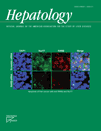Cystic fibrosis—cirrhosis, portal hypertension, and liver biopsy: Reply†
Potential conflict of interest: Nothing to report.
We welcome the letter by Witters et al.1 highlighting the important issue of noncirrhotic portal hypertension (NCPH) in cystic fibrosis (CF). This group's data are complementary to ours,2 focusing on liver biopsy findings in 12 patients (ages not supplied), all with established portal hypertension yet only five with established cirrhosis. Of seven cases without cirrhosis, four were from explanted livers permitting direct inspection and avoidance of sampling error. The presinusoidal origin of the portal hypertension was confirmed in two patients who had hepatic venous pressure gradients measured at only 5 and 9 mm Hg. Witters et al. also report portal venopathy in liver biopsies from all patients classified as NCPH (whose fibrosis on biopsy did not reach criteria for established cirrhosis), a finding more prevalent than in biopsies from an uncharacterized cohort of 20 children with CF-associated liver disease (CFLD) without portal hypertension.
In our study cohort of 40 patients, a group earlier in the natural history of CFLD with progression of some to advanced portal hypertension (nine at diagnosis and a further eight after 12 years of follow-up),2 there was no venopathy reported on biopsy. Two patients in our cohort who subsequently underwent transplantation had established cirrhosis in the explanted liver, and neither had portal venopathy. Portal venopathy is characterized by progressive histological changes, and we suspect that our failure to discern significant venopathy in patients with NCPH is because biopsy specimens were from patients earlier in the natural history of CFLD. We previously identified markedly increased numbers of activated hepatic stellate cells and myofibroblasts expressing α-smooth muscle actin (α-SMA) with contractile potential, within portal tracts and around hepatic sinusoids in children with CFLD without fibrosis.3 In our more recent study, we reported greatly increased α-SMA expression in the biopsies of children with CFLD, which was significantly associated with increasing stage of hepatic fibrosis.2 We suspect these contractile cells to have a major role in the development of early NCPH in CFLD.
The findings of Witters et al. give support to the experience of CF centers where development of portal hypertension precedes liver failure by many years or is not followed by failure at all. One child in our study with CF and moderate fibrosis had varices, proceeded to splenectomy for severe hypersplenism, and 12 years later continues to have normal liver function (untransplanted).
We agree that care must be taken not to underestimate the degree of portal hypertension based on liver biopsy. Portal hypertension is a dynamic process, where liver biopsy is a snapshot of histology and severity of cirrhosis and portal hypertension, and though closely related, they do not always match up. Witters et al. further highlight the context in which we wish our study to be interpreted. We demonstrated the value of liver biopsy to predict later morbidity and mortality in children suspected as having liver disease,2 whereas Witters et al. confirm what we only alluded to: the important role of NCPH in patients with advanced portal hypertension, particularly those considered for transplantation.1 Although sampling error is greatest in patients with established cirrhosis, the findings of Witters et al. give support to the role of liver biopsy in CF to guide clinicians to nontransplant alternatives in patients with problematic portal hypertension, particularly if biopsy reveals the absence of advanced liver damage.
We commend Witters et al. for their important contribution to elucidating the enigma that is CF liver disease and providing further understanding of the role of liver biopsy in this setting.
References
Peter J. Lewindon F.R.A.C.P.* , Grant A. Ramm Ph.D.*, * The Hepatic Fibrosis Group, The Queensland Institute of Medical Research, The University of Queensland, Brisbane, Australia, Department of Gastroenterology, Royal Children's Hospital, The University of Queensland, Brisbane, Australia, Pediatrics and Child Health, The University of Queensland, Brisbane, Australia.




